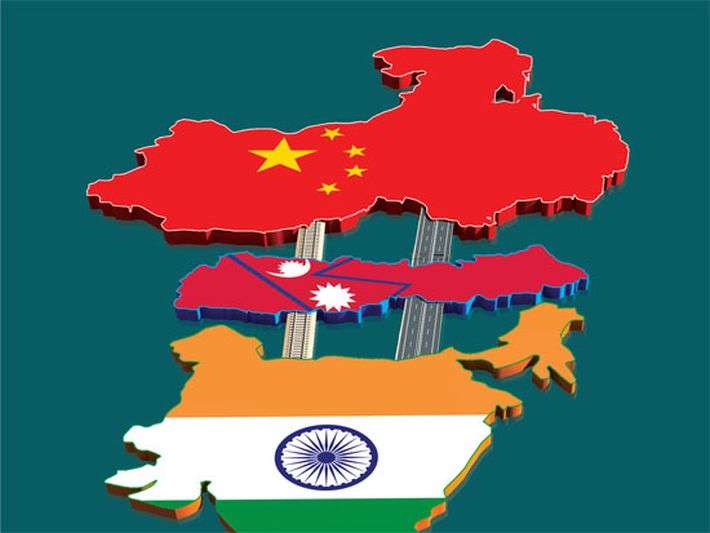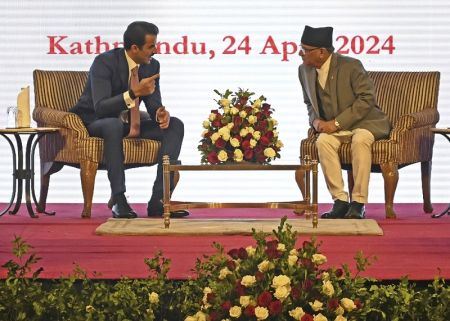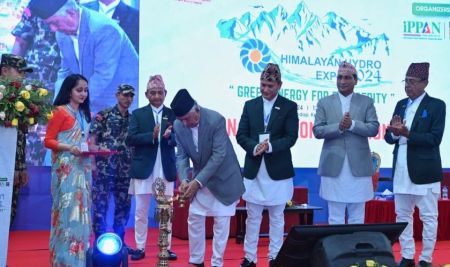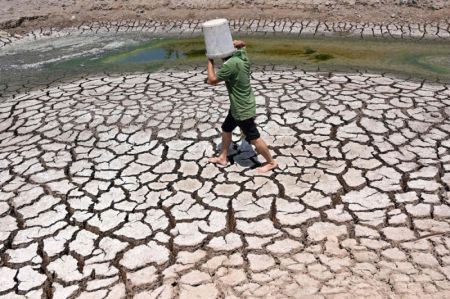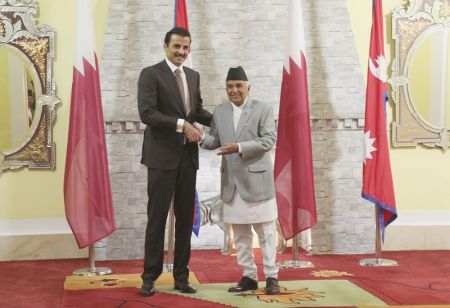Nepal is ideally located between India and China to work as a golden land-bridge between them and facilitate their bilateral trade. But for this to happen, all three countries must focus on Nepal's infrastructure development.
--By Akhilesh Tripathi
The notion that Nepal should move beyond the victim mindset of seeing itself as a landlocked country and try to capitalize on its status as a land-linked nation is gaining momentum. Economists, development planners, foreign policy experts and the business community are all increasingly arriving at the conclusion that the country should strive to establish itself as a trade corridor between its two giant neighbours, India and China, and benefit from their bilateral trade as a transit country.
Without any direct access to sea, Nepal shares a 1400 kilometers long border with China’s Tibet Autonomous Region (TAR) in the north and 1,700 kilometers long border with India in the east, west and south. Similarly, India and China share a 4500 kilometers long border but they have only one trade route currently operational between them – the Nathula Pass. On the other hand, the trade volume between China and India is ever-increasing. It is tipped to reach USD 100 billion by 2015. The Nathula Pass is not an all-season route. Snowy, risky and costly, this pass was closed following the 1962 India-China war and reopened in 2006 following some agreements between China and India.
Nepal’s geographical location, development planners say, is a good opportunity to make for the ‘disadvantage’ of lacking a direct access to sea. “We should stop cursing the land-locked status of Nepal. Instead, we should develop Nepal as a land-linked state. This requires a stronger focus on infrastructure and connectivity. But this is very much possible if our neighbours agree on it,” shares Gopi Nath Mainali, joint secretary and head of the Infrastructure Development Division under the National Planning Commission.
Mainali adds that Nepal is ideally located to work as a land-bridge between China and India, the two Asian giants, by means of highways and railroads connecting Nepal’s northern border with south. “In this way, Nepal could transform itself into a land-linked country from a landlocked one and at the same time provide transit facilities to both its neighbours,” he observes.
“Landlocked countries can now change their status by being land linking countries providing their land for transit use to their neighbours,” says Mainali, “We have seen this in Laos. If Laos can do it, so can Nepal.”
 Are the Neighbours Ready?
Are the Neighbours Ready?The first question that perhaps crops up in the mind once one envisages Nepal as a transit country between its neighbours is: Are the neighbours ready for it?
The answer perhaps lies in the fact that the China-India trade has been increasing consistently. According to available data, it has risen 15 folds over the past one decade. Most of this trade takes place through the marine route via Hong Kong. The Nathula Pass is located 4,400 meters above sea level and is quite far from India’s major industrial cities. This means transport is a bottleneck for growing China-India bilateral trade.
“Land and rail routes through Nepal would be a much better option for both India and China for their bilateral trade. Nepal is ideally located to work as a bridge between India and China. Both India and China know this fact,” says Dr Rishi Raj Adhikari, executive director of Institute of Foreign Affairs, a foreign policy think tank. Nepal could play the role of a golden bridge between the two emerging economic giants – India and China, and in the future, if China is linked to South Asia through Nepal, the entire population inhabiting the region will be immensely benefitted, he adds.
“If Nepal can allay its neighbours’ security concerns, there is no reason why India and China will not think about using the Nepal route for their bilateral trade,” claims Dr Adhikari.
During his recent Nepal visit, Indian Prime Minister Narendra Modi emphasized on a ‘H-I-T’ formula (Highways, Infoways and Transways) for Nepal’s development. While addressing Nepal’s parliament, Modi also promised cooperation in these areas. However, his 45-minute long speech did not carry a single word on China-Nepal-India cooperation.
Replying to the question if India is really interested in transforming Nepal into an economic corridor between India and China, Dr Adhikari says, “India must be interested because the Nepal corridor is a step towards fulfilling India’s ambition to play a central role in Asian trade, investment, energy, security and geopolitics. The Nepal corridor, along with the ones linking Central Asia, south-west China and Southeast Asia will be pivotal in fulfilling this goal.”
It is true that India and China have fought a war against each other in 1962 and that there are some border disputes between the two countries. But, according to foreign policy experts, both have realized that if political issues are allowed to dominate their economic ties, their growth aspirations of becoming economic superpowers will be seriously affected. Therefore, despite political differences and contentious border issues, China and India have forged a smooth economic partnership and are not interested in bringing political agenda at front at the expense of their economic interests.
Today, China and India have become substantial trading partners. In 2008, China overtook the United States to become India’s largest trading partner and, during President Hu Jintao’s 2010 visit to New Delhi, the two countries set a bilateral trade target of USD 100 billion by 2015.
According to officials at the Ministry of Foreign Affairs, during the Inter-Governmental Committee meeting in Kathmandu in January 2004, India officially asked Nepal to provide transit to China for carrying out trade through Nepali territory. In the same way, during his Nepal visit in 2012, Chinese Prime Minister Wen Jiabao and Chinese vice minister responsible for South Asia affairs, Ai Ping, held crucial conversation with their Nepali counterparts to foster bilateral and trilateral trade relationship.
“The growing trade between these two giant economies in the absence of a permanent and feasible trade corridor on their side seems to have necessitated them to opt for Nepal as their transit partner,” thinks Dr Adhikari, “That’s the reason our transitional trade routes, through which Indo-Chinese trade used to be conducted in the past, are to be reevaluated by both our neighbouring countries.”
Meanwhile, China has given high priority to connect Tibet with mainland China. According to China’s Xinhua news agency, the Lhasa-Shigatse extension of the Qinghai-Tibet Railway project will be completed a year ahead of schedule, in 2014. Trade experts think that China has realized that Nepal provides an excellent transit buffer for overland trading between them. That’s why China has been concentrating on the development of its western part in Tibet and Xinxiang.
“Lately, Tibet's GDP has been increasing at the rate of over 10 per cent. Similarly in India, the state of Bihar which was considered a problem state has now a growth rate of around 10 per cent. This means there is tremendous opportunity of trade between these new growth centers of India and China via the land route of Nepal,” shares economist Dr Madan Kumar Dahal.
.JPG)
Need for a Tri-partite Agreement
For Nepal to become a transit country or a bridge between its two mammoth neighbours, all three countries need to agree on it, especially its neighbours. This may require a trans-regional or tripartite transit arrangement among China, Nepal and India.
According to one school of thought, it is not easy to assure India and China as they have contrasting political and border disputes. On the other hand, the proponents of this school of thought argue, China and India have achieved significant progress in bilateral trade through the marine route and developing Nepal as a trade corridor may not be their dire need. “So, Nepal should take the initiation as this option will greatly benefit our economic development,” says Yam Prasad Chaulagain, one of the researchers of the study titled ‘Nepal’s New Foreign Policy Agenda: From Buffer to a Bridge’ on behalf of the IFA.
According to the other group of analysts who subscribe to the “Chindia” thesis, China-India relations in this age will be underscored by cooperation and mutual benefits. Neither China nor India can afford to allow the political issues to affect their common economic interests. So, the China-India trade is bound to prosper in the future, they argue.
“Rather than taking sides, Nepal should coordinate to bring its giant neighbours together to forge a trilateral partnership in a mutually constructive manner," Chaulagain says, “For this, a tripartite agreement on Trans-Himalayan Security and Economic Cooperation needs be formed, first and foremost.”
What Nepal is Doing
Nepal’s shift towards acting as a bridge seems to have emerged in 2001 with Late King Birendra’s visit to China. The visit succeeded in forging an agreement between Nepal and China to expedite the construction of the Syafrubesi-Rasuwa road – a second road linking Nepal to TAR.
Likewise, former King Gyanendra’s formal declaration of developing Nepal as a transit point between China and India at the Afro-Asian Summit in 2005 in Jakarta revived Nepal’s bridge ambition once again. Again in January 2012, the then Prime Minister Dr Baburam Bhattarai said that Nepal can and should act as a bridge between India and China and take advantage from the rapid economic development of the two biggest and fast growing economies. He further added that the concept of building an electric railway linking Birgunj (Nepal-India border) to Kathmandu and Kathmandu to Tatopani (Nepal-China border) should be brought into implementation for developing Nepal as a transit point between two neighbouring countries.
A major highway connecting Kathmandu with India via Birgunj/Raxual border point was built in the early 1950s with the assistance of India. Another major highway, connecting Kathmandu with Lhasa, Tibet’s capital, via Tatopani/Zhangmu (Khasa) border point, was built in the 1960s with the assistance of China.
Our border with India is open and geographically comfortable while the border with China has very tough terrain and accessibility issues. There are 27 routes for mutual trade and six immigration points between Nepal and India. They are connected by road. India has extensive highway and railway system. Several bordering towns-Birgunj, Janakpur, Nepalgunj- are connected to Indian towns by Indian railways.
On the other hand, Nepal and Tibet have 1414 kilometers long common international boarder. On China’s side, the border is shared by Tibet’s 7 Counties namely: Tingkey, Tingri, Naylam, Kyirong, Saga, Drongpa and Purang. The border touches 14 districts of Nepal, namely: Taplejung, Sankhuwasabha, Solukhumbu, Dolkha, Sindhupalchowk, Rasuwa, Manang, Mustang, Dolpa, Mugu, Humla, Bajhang and Darchula. However, so far, only Khasa (Zhangmu) of Tibet is linked with Kathmandu by a 130 kilometers long road.
Meanwhile, according to NPC officials, Nepal is constructing several north-south highways to connect its border in the north to that in the south. “Once these highways are completed, Nepal will be effectively linked with its neighbours,” says NPC joint secretary Mainali.
Ten of the 21 Projects of National Pride are related with the transportation sector including Mid-hill Highway, Kathmandu-Tarai Fast Track, Postal Highway, three north-south highways, east-west railway and three airports. However, the progress of these projects is not satisfactory. The works in three north-south highways in Koshi, Kaligandaki and Karnali corridors, which are included in the list of Project of National Pride, are also behind
the target.
.jpg)
Present Connectivity
At present, only the 393 km Birgunj-Kathmandu-Kodari road serves as a highway link between India and China. But this route is not wide enough and well maintained. According to officials at the Department of Roads, another highway route via Rasuwagadhi-Kerung is under construction and hasn’t been used for trading purpose yet. Similarly, Galchi-Rasuwa (18 km) part of Birgunj-Syafrubesi corridor has been completed with the financial assistance of Asian Development Bank (ADB). The Rasuwa-Syafrubesi-corridor part of Birgunj-Syafrubesi corridor has also recently been competed with the financial assistance of the Chinese government. It has been suggested that Raxaul-Trishuli-Rasuwa (265 km) will be the shortest highway connecting Nepal’s southern border with northern. The shortest potential transit routes, other than (Raxual- Trishuli- Rasuwa), are Janakpur-Dolakha-Lamabagar, Mohana-Dhangadhi-Atari-Tinker and Rani-Hile-Kimathanka. The Department of Roads (DoR) had proposed these roads well back in 2005. “Connectivity between India and China would be more efficient after the completion of these roads,” says Arjun Jung Thapa, deputy director general at DoR.
A Natural Transit State
Geographically, Nepal is a long and narrow stretch between China and India. It has multiple transit points at both sides of the border and therefore, can work as an excellent transit buffer to link China’s Tibet and its east-west highway network with the densely populated Indian plains of Bihar and Uttar Pradesh.
In recent times, China has prioritized linking TAR with mainland China through rail. As a result, TAR’s capital Lhasa has already been connected to mainland China by rail i.e. the Lhasa-Shigatse rail link has been completed recently. The Shigatse-Tatopani-Kathmandu-Birgunj link would be just 815 km between India and China while at present, the trade between western China and India requires over 5,000km of rail/road and sea transport.
The shortest potential transit routes between India and China other than the Raxaul-Trishuli-Rasuwa, as proposed by the Department of Roads, are Janakpur-Dolakha-Lambanagar; Mohana-Dhangadi-Atari-Baitadi-Darchula-Tinker; and Rani-Hile-Kimathanka. The corridors will have much easier access to the economic centres of Ahmadabad and Mumbai in India than the Tibet-Sikkim transit corridor. These Nepali corridors could be very useful in linking Central Asia, South-west China and South East Asia.
According to DoR officials, priority has been given to the construction of North-South connection. “Nepal has planned 11 north-south roads. Some of them are Birgunj-Galchi-Dhunnche-Rasuwagadhi, Biratnagar-Kimathanka, Bhittamod-Lamabagar, Benighat-Larkey, Bhairahawa-Jomsom-Korala, Nepalgunj-Surkhet-Hilsa and Mahendranagar-Darchula-Tinkar. The Birgunj-Syafrubesi corridor has been completed and the Rasuwa-Syafrubesi corridor (part of the Birgunj-Syafrubesi corridor) has also been recently completed with the assistance of the Chinese government,” shares Arjun Jung Thapa, deputy director at the Department of Roads.
What is China Doing?
Nepal and China are mulling over opening the Rasuwagadhi route for international trade within 2014 so as to provide an alternative roadway for imports and exports of goods between the two countries. Currently, Tatopani in Sindhupalchowk district serves as the only land route from where international trade between Nepal and China takes place. According to officials at the Ministry of Commerce and Supplies (MoCS), the Rasuwagadhi route is being opened as part of Nepali and Chinese governments’ plan to establish three ports for international trade at Tatopani, Rasuwagadhi and Yari. Another three routes, including those at Kimathanka and Lizi, would be used for bilateral trade, especially cross-border trade, say the MoCS officials.
China has already agreed to support Nepal to build an Inland Container Depot (ICD), or dry port, in Rasuwagadhi to strengthen Nepal’s trade infrastructure and narrow down trade deficit between the two countries. The MoCS plans to upgrade the customs office at Rasuwagadhi besides improving the road network in the area. The proposed dry port site will be located at a distance of 30 km from Dhunche, the headquarters of Nepal's Rasuwa district.
Similarly, China has already agreed, during the visit of the then Chinese Prime Minister Wen Jiabao in January 2012, to support Nepal in upgrading dry ports at all six major customs points along the northern border. The other dry ports that China has agreed to strengthen under the agreement on Management of Ports on the China-Nepal Border are Pulan-Yari in Humla district, Zangmu-Kodari in Sindhupalchok and Riwu-Olangchung Gola in Taplejung. Similarly, Lizi-Nechung in Mustang district and Chentang-Kimathanka in Sankhuwasabha district are among the border points where dry ports will be built with Chinese support.


